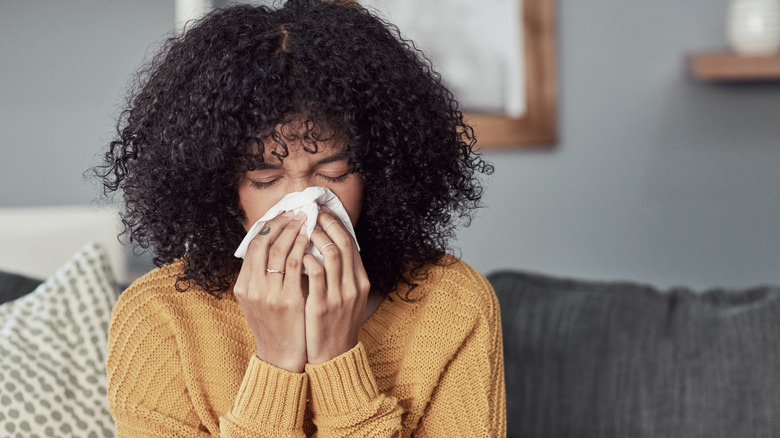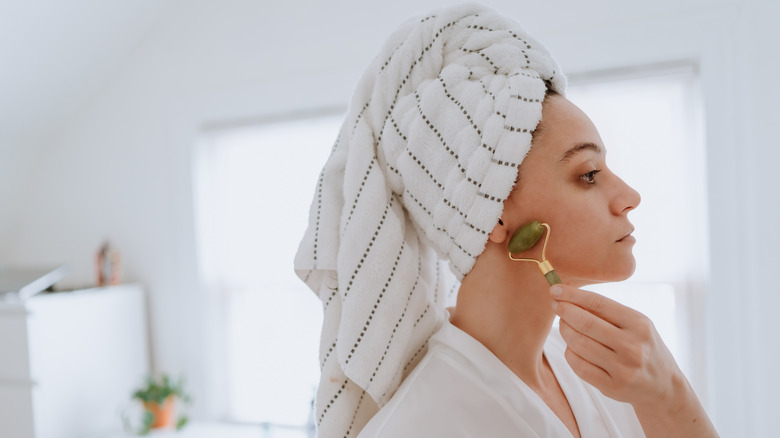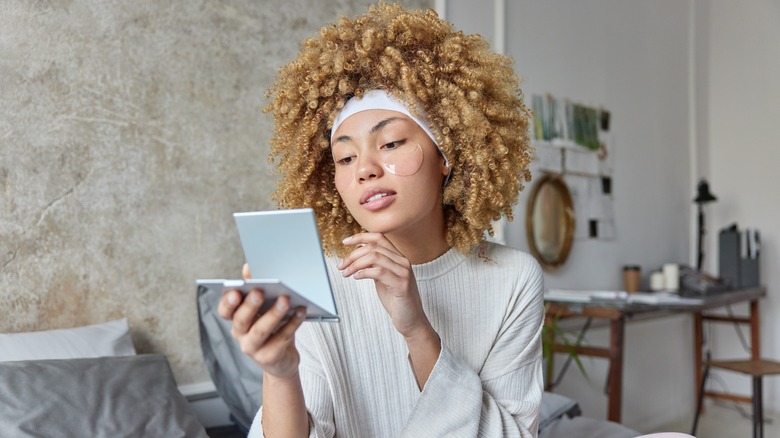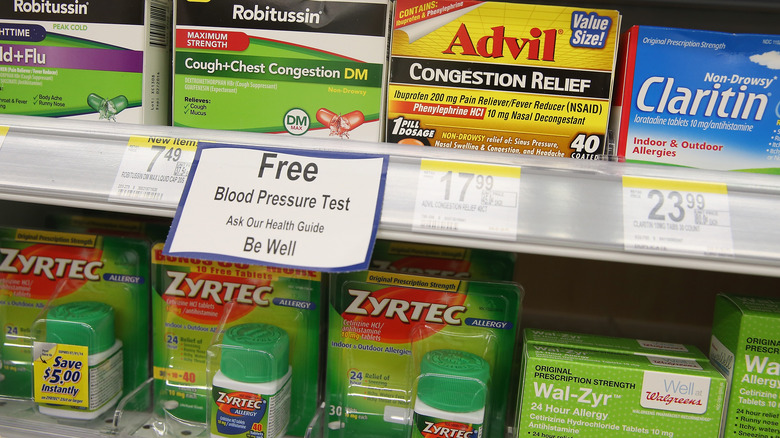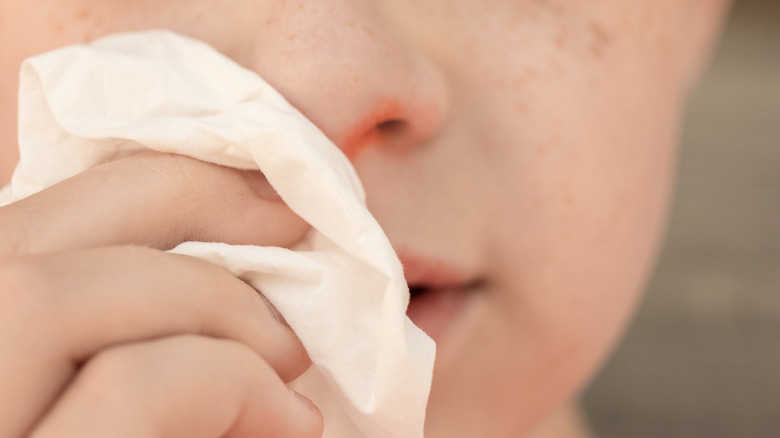Tips For Winning The Battle Against Allergy-Induced Puffy Face & Eyes
If you're one of the more than 50 million Americans who suffer from allergies, we have some bad news for you. Climate change has led to something called super pollen, and with its ability to travel up to fifty miles, your allergies are more than likely only going to get worse. With that in mind, it could be time to start tackling some of the allergy side effects that are impacting your life. While sneezing, coughing, and wheezing are bad enough as it is, the after-effects these symptoms can wreak on your skin and eyes can feel even worse.
From puffiness to nose chafe to bloodshot eyes, allergies can leave your face and eyes in rough shape. Since your skin is your largest organ and first line of defense against environmental factors like pollution and pollen, allergy season can also lead to an increase in skin irritation and rashes. Robb Akridge, PhD, the founder and CEO of Opulus Beauty Labs, explained to Refinery29, "Aside from these local reactions, people also get systemic reactions where your immune system responds, producing many inflammatory factors that cause your skin cells to react." Taking extra care of your skin, eyes, and even nose during allergy flare-ups can be the key to ensuring your face stays de-puffed. While there are definitely a lot of tips and tricks to help with puffiness, here are some allergy-specific tips you can try in order to make the season more manageable.
Try cold therapy
If you're struggling with puffiness face icing might be a great option for you. Not only are there a ton of different ways to approach face icing (which makes it customizable to what you're looking for) but it's also relatively inexpensive as an at-home therapy. Adding a cool element to your puffy face can not only feel soothing but can also help to reduce inflammation while breaking down fluid build-up under your skin. A jade roller, gua sha scraping tool, or even a cold spoon can all help you achieve the benefits of face icing with minimal financial outlay.
If you're looking to amplify the effects of face icing, trying a gua sha technique with your cooling tool of choice can also help you move fluid out of your face through your lymphatic drainage system. Acupuncturist Paige Yang, L.Ac, DACM, explained to mbg, "A lot of lymphatic fluid stagnates in the face. Gua sha can promote circulation of blood, promote your water metabolism in the face, and helps to keep the lymphatic system fresh." Use a flat tool (or specific gua sha tool) to scrape fluid under your skin down your face and through your neck. This can help to reduce the amount of fluid that might build up in your face due to allergies, especially around your eyes.
Add undereye treatments to your morning routine
Undereye masks have become all the rage in skincare, and they are perfectly suited for reducing the undereye fluid and puffiness that might be plaguing you thanks to your allergies. As dermatologist Michelle Henry, MD, explained to Refinery29, "Allergies trigger mast cells, which release histamine — the culprit behind all that itching — that causes the blood vessels to swell. These engorged vessels cause puffiness and dark circles."
As an added bonus, many of these undereye masks can be (and many even encourage being) placed in the fridge for added coolness and relief. This can add to the depuffing effects while also offering a more soothing experience. You can also help combat the dark circles that come with eye swelling by shopping for eye masks with caffeine and brightening ingredients. These will give your skin and undereye area an added boost while helping to minimize any discoloration. Another option to help you reduce your morning undereye situation is to sleep on an extra pillow to ensure fluid can't pool around your eyes at night.
Find the right allergy treatment
If your allergy symptoms are affecting your way of life, it could be worth pursuing over-the-counter medication to help you manage. Focusing on non-drowsy, all-day options can be your best bet when determining which allergy medication is right for you. Remember that different active ingredients can help your specific allergies more or less than others, so don't be afraid to try out multiple brands until you find what works. Save yourself some money while figuring out which medication you like best by buying generic ingredients rather than more expensive brand names (for instance, look for loratadine instead of Claritin or cetirizine HCL instead of Zyrtec). By minimizing your sneezing and itching symptoms you can help reduce puffiness in your face as well as bloodshot eyes (plus, less sneezing will ultimately make your life a little better).
If you're looking to stay more natural with your allergy treatment, pursuing a neti pot for sinus cleansing can be a useful alternative. Neti pots allow you to rinse your nasal passages which can be helpful when treating allergies as well as colds and congestion. Make sure to only use distilled, sterile, or previously boiled water to avoid any potential infections. Another option can be to pursue natural supplements and ingredients. For instance, some research has found that milk thistle can help your body better fight off allergy and hay fever symptoms. As always, it is best to talk with a medical professional before pursuing at-home supplements or medications.
Invest in different skincare products
In case you didn't already know this, there are actually three kinds of moisturizers (we have a guide here) and they all serve different functions for your skin and beauty routines. Occlusives are the thickest and heaviest of the three, and they serve as a protecting barrier. If you find your nose chafed or even rubbed raw from near-constant exposure to tissues, using an occlusive moisturizer like Vaseline or Aquaphor can help protect your sensitive skin areas from further damage. As an added bonus, these moisturizers create a protective film around your skin that can also keep pollens, allergens, and irritants out. This can help you prevent further irritation while also giving your skin time to heal.
It might also be worth researching specially formulated anti-pollution skincare products, especially if you're dealing with topical allergies like rashes. These products can help combat the damaging effects of the pollutants that are contributing to your allergies in the first place. Dermatologist Howard Murad explained to Refinery29, "Pollutants trigger the immune system to produce excessive melanin, which causes pigmentation, skin darkening, and inflammation, and weakens the skin's barrier, causing lines and wrinkles. As a result, pollution is one of the major sources of concern for health and beauty." By utilizing the anti-inflammatory properties of ingredients like Vitamin C and the moisturizing effects of occlusives to lock out pollutants, you can help prevent the long-term effects of pollutants and allergens from negatively impacting your skin.
